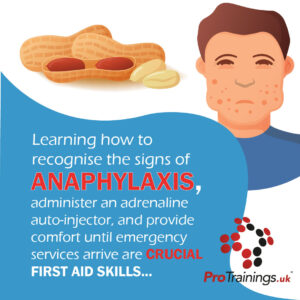Dealing with Allergic Reactions: First Aid for Anaphylaxis
Anaphylaxis is a severe and potentially life-threatening allergic reaction that requires immediate medical attention. Knowing how to respond quickly and effectively can save lives. This guide provides essential first aid steps for dealing with allergic reactions, including recognising the signs of anaphylaxis and what to do in an emergency.
1. Understanding Anaphylaxis
Anaphylaxis is a rapid and severe allergic reaction that can occur within minutes of exposure to an allergen. Common triggers include:
- Food Allergens: Such as peanuts, tree nuts, shellfish, and dairy products.
- Insect Stings: From bees, wasps, or hornets.
- Medications: Such as antibiotics or non-steroidal anti-inflammatory drugs (NSAIDs).
- Latex: Commonly found in medical gloves and some medical devices.
2. Recognising the Signs of Anaphylaxis
Knowing the signs of anaphylaxis is crucial for providing timely assistance:
- Skin Reactions: Hives, itching, and swelling, particularly of the face, lips, tongue, or throat.
- Breathing Difficulties: Wheezing, shortness of breath, or a feeling of tightness in the chest.
- Circulatory Symptoms: Rapid or weak pulse, dizziness, fainting, or a drop in blood pressure.
- Gastrointestinal Symptoms: Nausea, vomiting, abdominal pain, or diarrhoea.
- Mental Confusion: Anxiety, confusion, or a sense of impending doom.
3. Immediate First Aid Steps for Anaphylaxis
If someone is experiencing anaphylaxis, it’s vital to act quickly:
Step 1: Call 999 Immediately
- Seek Emergency Help: As soon as you recognise the signs of anaphylaxis, call 999 or ask someone else to do so. Inform the operator that the person is experiencing anaphylaxis.
Step 2: Administer an Adrenaline Auto-Injector
- Use an Auto-Injector: If the person has a prescribed adrenaline auto-injector (e.g., EpiPen or Jext), administer it immediately. Inject it into the outer thigh, holding it in place for about 10 seconds but read the instructions as each brand of auto-injector is different.
- Note the Time: Keep track of the time when the injection was given, as this information is important for the emergency responders.
Step 3: Help the Person Stay Comfortable
- Lie Them Down: If the person feels faint, encourage them to lie down flat with their legs elevated. This helps improve blood circulation.
- Keep Them Calm: Reassure the person and encourage them to stay calm while waiting for emergency services.
- Avoid Food or Drink: Do not give them anything to eat or drink, as it could worsen the situation.
Step 4: Administer a Second Dose if Needed
- Monitor Symptoms: If there is no improvement after 5-15 minutes and emergency services have not yet arrived, administer a second dose of adrenaline if available and if advised to do so by a healthcare professional.
4. After the Emergency
Once the immediate danger has passed and the person is stable:
- Medical Evaluation: Even if the symptoms improve after administering adrenaline, the person should be taken to hospital for further observation and treatment. Anaphylaxis can have a biphasic reaction, where symptoms return after a few hours.
- Allergy Testing: Encourage the person to follow up with an allergist for further testing and to identify the specific allergen.
- Action Plan: If they don’t already have one, suggest they work with their healthcare provider to create an anaphylaxis action plan, including when and how to use an auto-injector.
5. Preventing Future Episodes
Prevention is key to managing severe allergies:
- Avoid Known Allergens: Once an allergen is identified, the person should avoid it as much as possible. This may involve reading food labels carefully, asking about ingredients in restaurants, and avoiding areas where allergens are present.
- Educate Friends and Family: Make sure those close to the person are aware of their allergy and know how to use an adrenaline auto-injector in case of an emergency.
- Carry an Auto-Injector: People at risk of anaphylaxis should always carry an adrenaline auto-injector with them, and possibly have a spare in a different location, such as work or school.
Conclusion
Anaphylaxis is a serious condition that requires immediate attention, but with the right knowledge and preparation, you can respond effectively and save lives. Learning how to recognise the signs of anaphylaxis, administer an adrenaline auto-injector, and provide comfort until emergency services arrive are crucial first aid skills. If you or someone you know is at risk, consider taking a first aid course to further enhance your understanding and readiness.

